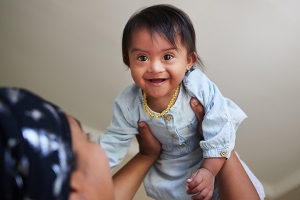
It is estimated that 15 percent of infants and children in intensive care units are there due to an underlying genetic condition. Just a few years ago, many of these infants would pass away or go through childhood with significant health problems without doctors or family knowing why. Traditional genetic testing takes weeks to be returned, which may mean that a potentially treatable genetic condition is not identified until after the window of opportunity to improve the child’s outcome has passed.
Rady Children’s Institute for Genomic Medicine (RCIGM) has developed rapid, comprehensive genomic testing that can provide a genetic diagnosis for an acutely-ill child in a few days. Rapid and ultra-rapid whole genome sequencing transform the diagnosis and treatment for children with rare genetic disorders. Dr. Stephen Kingsmore and his multidisciplinary team focus on preventing, diagnosing, treating and curing childhood disease through genomics. The team has run rapid whole genome sequencing on 2,000 infants from Rady Children’s Hospital and over 45 partner hospitals across the country. Approximately one out of three children having this test receives a genetic diagnosis.
What is Whole Genome Sequencing (WGS)?
A genome is like a blueprint for a building; it contains all the instructions for how we grow, develop and maintain our bodies. A human’s genetic code, or DNA sequence, is made up of over six billion letters (nucleotides). Normal variations or spelling changes in this code simply make us different from one another. However, occasionally one of these spelling changes can seriously change an instruction, or a gene, enough to disrupt normal development and cause a genetic disorder.
The significant challenge for a laboratory that runs whole genome sequencing is to filter through millions of variants, or spelling changes, that are not disease-causing to find the one or two that are. It is literally like finding a needle in a haystack. Sequencing of the first human genome took 13 years; the typical time to sequence and analyze a critically-ill child’s genome at RCIGM is 3–5 days. Rapid WGS is more comprehensive than other genetic tests and results are communicated to clinicians in a shorter amount of time.
Patient Stories
Maverick appeared to be a healthy newborn when his parents took him home after birth, but he stopped eating and started having seizures in less than a week. He was admitted to the hospital, where uncontrolled seizures continued and his parents were given a very poor prognosis. At six days old, samples were sent to RCIGM for testing. Maverick’s doctors received a call less than two days later—the genetic cause of his seizures was found and it was treatable! His seizures were due to the body’s inability to use vitamin B6. With vitamin B6 and other dietary supplements, his seizures are now fully controlled and he is an active 2-year-old.
Lily (3 months old) was admitted to the hospital because she was not gaining weight as expected and had low blood sugar or hypoglycemia. During an ultrasound, her kidneys were found to contain a build-up of calcium which was possibly affecting her liver. Her doctors suspected a genetic condition and sent samples to RCIGM for testing. Less than 36 hours later, her clinical team was informed that Lily had a rare genetic condition that does not allow her body to break down fructose, a form of sugar. The doctors prescribed formula without fructose; Lily’s condition improved and she was discharged. Lily will be monitored by metabolic specialists and fructose will continue to be restricted, but having the issue identified so early may prevent more serious damage to her kidneys and liver.
Project Baby Bear Improves Outcomes
To expand access to whole genome sequencing, RCIGM is engaged in several projects to demonstrate that it helps doctors take better care of critically-ill children and saves healthcare costs. In 2020, RCIGM successfully completed Project Baby Bear (PBB). The state of California provided funding for rapid WGS for 178 critically-ill babies covered by Medi-Cal. The pilot study took place across five California hospitals. Forty-three percent of infants received a genetic diagnosis that explained the reason for their hospital admission and 31 percent had their medical management changed due to the diagnosis. This project also found that negative results were helpful to the clinical team, allowing them to rule out some, if not all, suspected genetic conditions.
PBB showed that the use of rapid WGS led to a reduction of $2.5 million in overall healthcare spending, saving parents and healthcare systems a ton of money. It permitted doctors to discharge babies sooner (513 fewer hospital days) and reduced the number of invasive procedures that would have otherwise been used to find a diagnosis. Data from projects like PBB may lead to rapid WGS becoming a covered insurance benefit for acutely ill infants and children suspected of having an underlying genetic disorder.
To learn more, visit the Rady Children’s Institute for Genomic Medicine at www.radygenomics.org.
Whole Genome Sequencing Quick Guide
Identifying a timely genetic diagnosis is important for many reasons, including:
- Guides clinical management
- Improves patient outcomes and quality of life
- Answers the “why” for a family
- Decreases healthcare costs
- Identifies other family members who may be at risk of having the same condition
Lisa Salz, MS, LCGC is a genetic counselor at Rady Children’s Institute for Genomic Medicine.
____________














